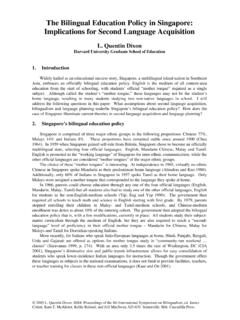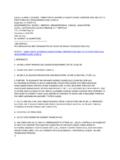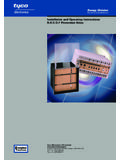Transcription of G u id an ce o n d os e leve l select ion fo r reg ulatory ...
1 Guidance on dose level selection for regulatory general toxicology studies for pharmaceuticals The 3Rs: Replacement refers to methods that replace or avoid the use of animals in areas where animals would have otherwise been used Reduction refers to methods which minimise animal use and enable researchers to obtain comparable levels of information from fewer animals or to obtain more information from the same number of animals, thereby reducing future use of animals Refinement refers to improvements to husbandry and procedures that minimise actual or potential pain, suffering.
2 Distress or lasting harm and/or improve animal welfare in situations where the use of animals is unavoidable Contents 1 Background 5. 2 Objectives and scope 6. 3 Introduction to dose selection 8. Animal use in preclinical safety studies Regulatory requirements to determine toxicity and dose response Establishing toxicity and managing adverse effects 4 Selection of the high dose 11. Maximum Tolerated Dose Limit dose Toxicokinetics and saturation of exposure Maximum Feasible Dose Doses providing a 50-fold margin of exposure 5 Principles of good practice in regulatory general toxicology studies 16.
3 Rodent to non-rodent test cascade Anticipating potential adverse effects Staged or staggered approaches to dosing Study management 6 Dose range finding 19. Guidance for dose range finding study design 7 Regulatory toxicology studies 22. General guidance for dose selection Guidance for selecting the high dose Guidance for selecting the low dose Guidance for selecting the intermediate dose 8 Concluding comments 31. 9 Acknowledgements 31. 10 References 32. 11 Abbreviations 33. 12 Definitions 34. Guidance on dose level selection | 3. Authors: Sally Robinson (AstraZeneca, LASA).
4 Kathryn Chapman (NC3Rs). Shirley Hudson (Compliance Services International). Sue Sparrow (GlaxoSmithKline). Derrick Spencer-Briggs (Huntingdon Life Sciences). Andy Danks (Charles River). Rose Hill (Sequani Ltd). David Everett (Covance Laboratories). Brigitte Mulier (Fulcrum Pharma (Europe) Ltd, previously at Aptuit Ltd). Sally Old (Sanofi-Aventis). Christopher Bruce (Pfizer). This document does not necessarily reflect the view of the individual companies/organisations that contributed. Observers: Elspeth Scott (Animals (Scientific Procedures) Inspectorate). Corresponding authors: Date of publication: December 2009.
5 The Association of the British Pharmaceutical Industry (ABPI) and the British Toxicology Society (BTS) support the guidance in this document. 4| Guidance on dose level selection 1 Background The National Centre for the Replacement, Refinement and Reduction of Animals in Research (NC3Rs) and the Laboratory Animal Science Association (LASA) share the common goal of promoting the principles of the 3Rs the replacement, refinement and reduction of animal use in research (1,2). Together, the organisations have formed an expert working group that comprises toxicologists from the UK's major pharmaceutical companies and contract research organisations.
6 The group aims to facilitate good practice in the design and conduct of regulatory toxicology studies by sharing information on practices across the industry. It is a scientific, ethical and regulatory requirement that before any potential new medicine can be administered to man its safety must be investigated in animals in order to define safe human doses. These animal tests are intended to reveal potential toxicity associated with the prospective medicine. While this requirement remains, it is essential to minimise the number of animals used and the adverse effects they may experience.
7 Since the objective of toxicology studies in animals is to identify potential toxic effects in humans, some of the animals used will suffer adverse effects. However, careful consideration and design of studies can reduce the impact on animals without compromising scientific goals or human safety and may indeed improve the quality of scientific data (3). Guidance on dose level selection | 5. 2 Objectives and scope A key objective of the NC3Rs/LASA collaboration is to provide practical guidance for Study Directors and other toxicologists working in the field of regulatory toxicology.
8 This document is aimed specifically at scientists that are new to, or training in, the role of Study Director. Drawing on the knowledge and experience of the working group members, the guidance document is intended to supplement the process of training and mentoring of Study Directors to improve the scientific outcome of regulatory general toxicology studies (see Figure 1) and to promote the application of the 3Rs. This is achieved by a series of recommendations that are considered good practice by the group. The guidance provided in this document has the potential to make substantial progress in reducing and refining animal use in this area, through avoiding unnecessary exposure of animals to marked adverse effects thereby reducing inadvertent morbidity and mortality and avoiding potential repetition of toxicology studies (see concluding comments).
9 Safety assessment studies in animals span several disciplines (safety pharmacology, general toxicology, genetic toxicology, reproductive toxicology, immunotoxicology). The dose selection guidance in this document focuses on general toxicology studies but many of the principles apply to studies in other disciplines. This document focuses on dose selection for: n Preliminary short duration studies ( dose range finding). n Regulatory toxicology studies that are required for first clinical trials in humans ( good laboratory practice [GLP] two week or one month studies or cyclical dosing regimens for anti-cancer drugs).
10 N Longer term studies ( three and six month studies). Written within the context of the UK regulatory system for the use of animals, the Animals (Scientific Procedures) Act 1986 (ASPA) (4), the principles outlined in this document are applicable to studies submitted to regulatory authorities worldwide. The recommendations are for standard routes of administration such as oral and intravenous. Specialised routes including inhalation and continuous infusion are not covered. Information on these routes can be obtained from relevant textbooks (5, 6). Dose selection for biopharmaceuticals is also out of the scope of this document.



